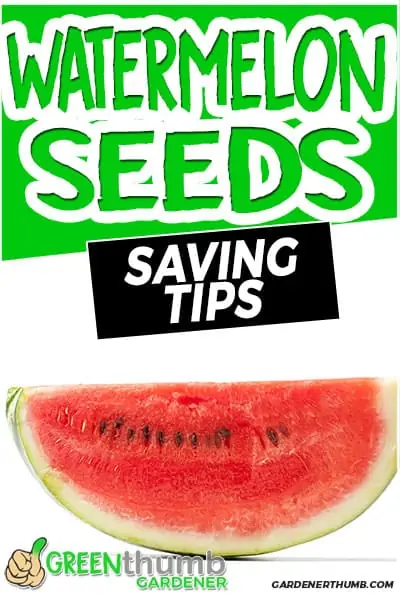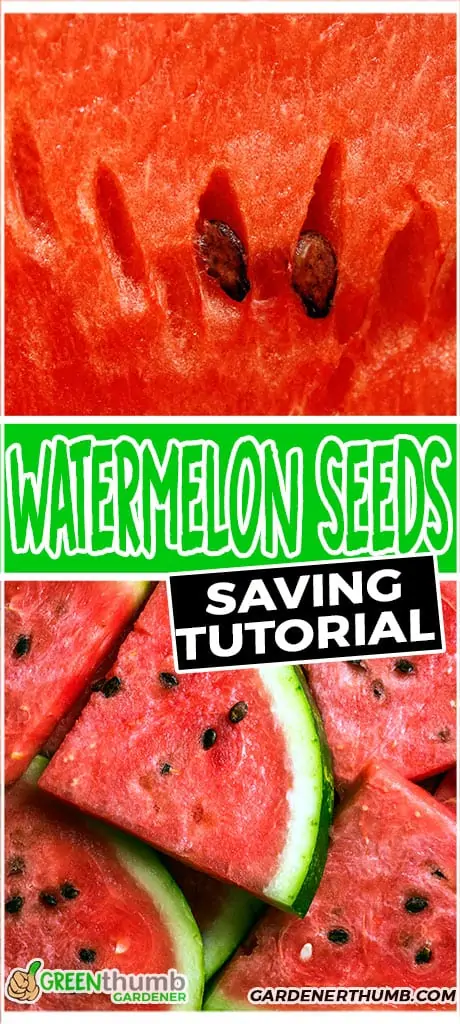Saving Watermelon Seeds Tips
Last updated: 11/01/21
The world record for watermelon seed spitting is 68 feet, 9 ⅛ inches.
While saving seeds from watermelons so you can practice your distance is a good way to pass the time, consider saving a few to grow your own watermelon plants as well!
Just a handful of watermelon seeds will net you a garden full of sweet, juicy watermelons next year. Most variety of watermelon seeds are some of the easiest to harvest, store, and grow.
Read on to learn how to save watermelon seeds.
Green thumb Gardener occasionally links to product and/or services offered by vendors to assist you with all your gardening needs. Some of these may be affiliate links, meaning we earn a small commission if items are purchased.
Want to Download a Garden Hack Guide for FREE

Enter your email below and we will send you a guide to help you SAVE money in your garden.
How to Grow Watermelons To Boost Seed Production
The most reliable way to harvest quality watermelon seeds appropriate for saving and planting is to select them from your own home-grown heirloom variety of watermelons.
Watermelons can be seeded directly into the ground or started indoors while the weather is still cool. They do not tolerate cool weather well, and some varieties have a particularly long growing window.
Make sure to learn about the variety you are cultivating and develop a plan based on your own growing season.
Watermelon plants need plenty of space in your garden that gets full sunlight for 8-10 hours a day.
As they grow, their vines will sprawl from their hill and loop around other plants, trellises, fences, and anything else nearby!
Watermelons can cross pollinate with other melon varieties plants to create hybrid fruits. Make sure to plant your watermelon crop far away from other melons (including other varieties of watermelons)!

If you live in a dry climate, water your watermelon plants every few days to ensure the soil stays damp but not soggy.
Keep an eye out for fungal infections on the leaves and pests.
Both can be treated if caught early. Watermelons tend to be resource hogs; consider fertilizing your heirloom watermelons to ensure healthy growth.
As watermelons ripen, their shiny rinds will turn dull green, their stripes will morph into broken lines, and the part of the fruit touching the ground may yellow.
When thumped, a ripe watermelon will sound hollow. The tendrils and leaves nearest the stem will also begin to turn brown and dry. All of these changes let you know that it’s time to harvest!
Harvesting Watermelon Seed Tips & Hacks
Avoid Hybrid Seeds
When selecting watermelon seeds to harvest and keep, save yourself some heartache by ensuring the fruit you are taking seeds from is not a hybrid.
Watermelons are open-hybrid plants, meaning insects and wind pollinate their flowers. However, different varieties of watermelon cross-pollinate easily, which creates hybrid fruits.
Seeds from hybrid plants will not produce fruit. This is the primary reason it is not always a great idea to plant seeds from the melon you brought home from the grocery store — there is no way to know if that watermelon was a hybrid or not.
If you are planting your watermelons from seeds you have purchased, check the package for more information. Ones labelled ‘open-pollinated’ or ‘heirloom’ will have seeds great for saving.
For more information on the difference between heirloom variety & hybrid varieties, take a look at our article on Seed Saving Fundamentals.
Selecting The Right Types of Watermelons Plants
Only save seeds from the best of your watermelon crop. It can be helpful to number or mark fruit that look like good candidates early in the season so you can track them over time and keep notes.
There are many factors that you might want to select for.
Hardiness
Does the plant tolerate weather changes well? Is it overly sensitive to changes in the soil or moisture? A hot summer day will suck the moisture right out of plants if not water properly.
Some varieties of watermelons are more drought resistant if you live in a hot climate.
Growth Rate
Does the plant grow quickly? Does it begin to produce fruit early or late and how does that line up with your growing season? Most garden watermelon varieties take 80 to 100 days to grow.
Consider a smaller watermelon cultivar type if you have a short season
Disease Resistance
Does the plant stay healthy and clear of fungus or other diseases throughout the growing season? A single watermelon plant is susceptible to many diseases such as black rot
Yield
Does the plant produce many watermelons? Some of my favorite watermelon varieties only produce 2 good ones to eat. Check as some varieties may produce more.
Quality
Are the types of melons produced mouthwatering delicious?
Narrow down your selection of fruits over the course of the growing season and don’t be shy about adding or removing fruit from your list as your plants develop.
By the end of the season, aim to have fruit from 5-10 plants selected to ensure diversity in your future crops.
Harvesting Seeds
To harvest your watermelon seeds, simply save them from fruit as you slice and eat it!
That said, if you are planning to salt your watermelon or use it in a dish, it is best to pull out the seeds you want before doing so. Also, if you have a fruit you definitely want to save the seeds from, don’t let it sit too long in the garden.
It is possible for the seeds inside the fruit to begin sprouting.

Saving & Storing Watermelon Seed For The Long Run
Once you have selected the fruit you want to collect seeds from, the saving and storing process is straightforward. After cutting into a watermelon, scoop the seeds into a bowl.
The seeds you collect should be plump and whole – toss any that are broken or shriveled into the trash. Rinse the fruit off of your seeds and drop them into a bowl of water.
A good, viable watermelon seed will float to the top of the water, while the damaged ones will sink. Strain the water from your good seeds and spread them out on a paper towel to dry.
Keep them out of direct sunlight as they dry. It generally takes 5-7 days to dry seeds out completely.
Do not rush this process – any moisture left in the seeds can cause them to spoil or mildew during storage.
After your seeds are dry, slide them into an envelope and store them somewhere cool and dark. Seeds saved in this way will keep for 4-5 years.

Further Reading
Final Thoughts
There is nothing more satisfying than a fresh, sweet, home-grown watermelon. As one of the easiest plants to harvest and save seeds from, there is no reason you can’t enjoy watermelon year after year.
Because each fruit will produce dozens of viable seeds, there will be more than enough to both save and use as you perfect your seed-spitting technique!








